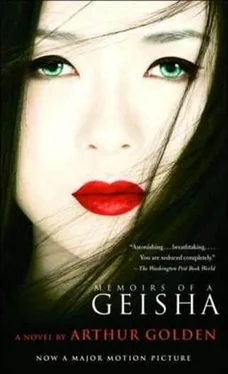
I’ve heard it said that the week in which a young girl prepares for her debut as an apprentice geisha is like when a caterpillar turns into a butterfly. It’s a charming idea; but for the life of me I can’t imagine why anyone ever thought up such a thing. A caterpillar has only to spin its cocoon and doze off for a while; whereas in my case, I’m sure I never had a more exhausting week. The first step was to have my hair done in the manner of an apprentice geisha, in the “split peach” style, which I’ve mentioned. Gion had quite a number of hairdressers in those days; Mameha’s worked in a terribly crowded room above an eel restaurant. I had to spend nearly two hours waiting my turn with six or eight geisha kneeling here and there, even out on the landing of the stairwell. And I’m sorry to say that the smell of dirty hair was overpowering. The elaborate hairstyles geisha wore in those days required so much effort and expense that no one went to the hairdresser more than once a week or so; by the end of that time, even the perfumes they put in their hair weren’t of much help.
When at last my turn came, the first thing the hairdresser did was put me over a large sink in a position that made me wonder if he was going to chop off my head. Then he poured a bucket of warm water over my hair and began to scrub it with soap. Actually “scrub” isn’t a strong enough word, because what he did to my scalp using his fingers is more like what a workman does to a field using a hoe. Looking back on it, I understand why. Dandruff is a great problem among geisha, and very few things are more unattractive and make the hair look more unclean. The hairdresser may have had the best motives, but after a while my scalp felt so raw, I was almost in tears from the pain. Finally he said to me, “Go ahead and cry if you have to. Why do you think I put you over a sink!”
I suppose this was his idea of a clever joke, because after he’d said it he laughed out loud.
When he’d had enough of scraping his fingernails across my scalp, he sat me on the mats to one side and tore a wooden comb through my hair until the muscles of my neck were sore from pulling against him. At length he satisfied himself that the knots were gone, and then combed camellia oil into my hair, which gave it a lovely sheen. I was starting to think the worst was over; but then he took out a bar of wax. And I must tell you that even with camellia oil as a lubricant and a hot iron to keep the wax soft, hair and wax were never meant to go together. It says a great deal about how civilized we human beings are, that a young girl can willingly sit and allow a grown man to comb wax through her hair without doing anything more than whimpering quietly to herself. If you tried such a thing with a dog, it would bite you so much you’d be able to see through your hands.
When my hair was evenly waxed, the hairdresser swept the forelock back and brought the rest up into a large knot like a pincushion on the top of the head. When viewed from the back, this pincushion has a split in it, as if it’s cut in two, which gives the hairstyle its name of “split peach.”
Even though I wore this split-peach hairstyle for a number of years, there’s something about it that never occurred to me until quite some time later when a man explained it. The knot-what I’ve called the “pincushion”-is formed by wrapping the hair around a piece of fabric. In back where the knot is split, the fabric is left visible; it might be any design or color, but in the case of an apprentice geisha-after a certain point in her life, at least-it’s always red silk. One night a man said to me:
“Most of these innocent little girls have no idea how provocative the ‘split peach’ hairstyle really is! Imagine that you’re walking along behind a young geisha, thinking all sorts of naughty thoughts about what you might like to do to her, and then you see on her head this split-peach shape, with a big splash of red inside the cleft… And what do you think of?”
Well, I didn’t think of anything at all, and I told him so.
“You aren’t using your imagination!” he said.
After a moment I understood and turned so red he laughed to see it.
* * *
On my way back to the okiya, it didn’t matter to me that my poor scalp felt the way clay must feel after the potter has scored it with a sharp stick. Every time I caught a glimpse of myself in the glass of a shop, I felt I was someone to be taken seriously; not a girl anymore, but a young woman. When I reached the okiya, Auntie made me model my hair for her and said all sorts of kind things. Even Pumpkin couldn’t resist walking once around me admiringly-though Hatsumomo would have been angry if she’d known. And what do you suppose Mother’s reaction was? She stood on her tiptoes to see better-which did her little good, because already I was taller than she was-and then complained that I probably ought to have gone to Hatsumomo’s hairdresser rather than Mameha’s.
Every young geisha may be proud of her hairstyle at first, but she comes to hate it within three or four days. Because you see, if a girl comes home exhausted from the hairdresser and lays her head down on a pillow for a nap just as she did the night before, her hair will be flattened out of shape. The moment she awakens, she’ll have to go right back to the hairdresser again. For this reason, a young apprentice geisha must learn a new way of sleeping after her hair is styled for the first time. She doesn’t use an ordinary pillow any longer, but a takamakura -which I’ve mentioned before. It’s not so much a pillow as a cradle for the base of the neck. Most are padded with a bag of wheat chaff, but still they’re not much better than putting your neck on a stone. You lie there on your futon with your hair suspended in the air, thinking everything is fine until you fall asleep; but when you wake up, you’ve shifted somehow so that your head has settled back on the mats, and your hairstyle is as flat as if you hadn’t bothered to use a tall pillow in the first place. In my case, Auntie helped me to avoid this by putting a tray of rice flour on the mats beneath my hair. Whenever my head drooped back while I slept, my hair sank into the rice flour, which stuck to the wax and ruined my hairstyle. I’d already watched Pumpkin go through this ordeal. Now it was my turn. For a time I woke up every morning with my hair ruined and had to wait in line at the hairdresser for my chance to be tortured.
* * *
Every afternoon during the week leading up to my debut, Auntie dressed me in the complete regalia of an apprentice geisha and made me walk up and down the dirt corridor of the okiya to build up my strength. In the beginning I could scarcely walk at all, and worried that I might tip over backward. Young girls dress much more ornately than older women, you see, which means brighter colors and showier fabrics, but also a longer obi. A mature woman will wear the obi tied in back in a manner we call the “drum knot,” because it makes a tidy little box shape; this doesn’t require very much fabric. But a girl younger than around twenty or so wears her obi in a showier fashion. In the case of an apprentice geisha, this means the most dramatic fashion of all, a darari-obi -“dangling obi”-knotted almost as high as the shoulder blades, and with the ends hanging nearly to the ground. No matter how brightly colored a kimono might be, the obi is nearly always brighter. When an apprentice geisha walks down the street in front of you, you notice not her kimono but rather her brilliantly colored, dangling obi-with just a margin of kimono showing at the shoulders and on the sides. To achieve this effect the obi must be so long that it stretches all the way from one end of a room to the other. But it isn’t the length of the obi that makes it hard to wear; it’s the weight, for it’s nearly always made of heavy silk brocade. Just to carry it up the stairs is exhausting, so you can imagine how it feels to wear it-the thick band of it squeezing your middle like one of those awful snakes, and the heavy fabric hanging behind, making you feel as if someone has strapped a traveling trunk to your back.
Читать дальше













